Learning to knit and block lace is like accessing a superpower that you’ve had all along. Increases and decreases—otherwise mistakes in ordinary knitting—are rhythmic and engaging to knit. While each row is a simple sequence, the rows build on each other to create delicate patterns that emerge from your needles like magic. Blocking opens up the fabric, turning subtle texture into stunning lace.
In the stunning Whisper Wrap by Lena Skvagerson, a chevron lace border gives way to a six-stich, four-row diamond lace repeat that forms the main body of the shawl. To preserve the symmetry of the lace direction, you’ll knit two identical panels, then join them in the center. Knitted in Yarn Citizen’s Trinity Cashmere, a luxurious blend of ultra baby alpaca, silk, and cashmere, the Whisper Wrap is an elegant piece you’ll treasure for years to come.
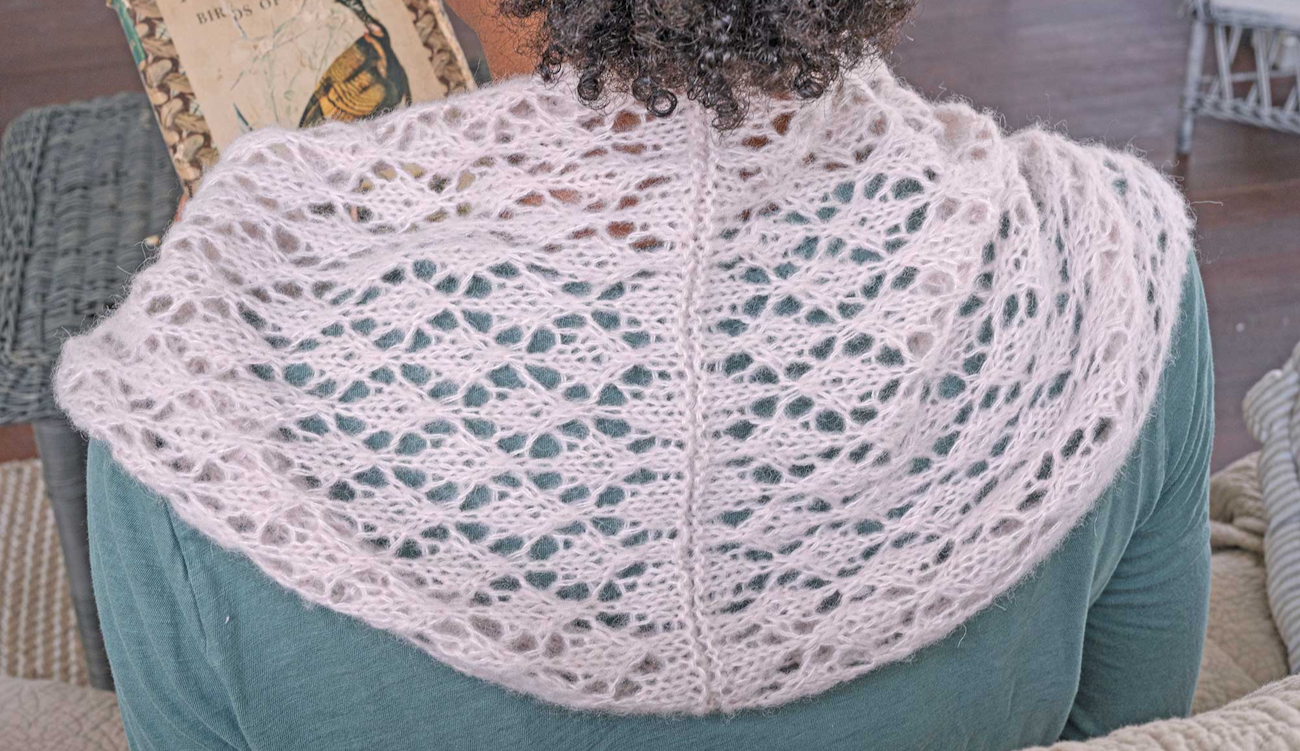 Blocking brings out the diamond lace repeats in the Whisper Wrap.
Blocking brings out the diamond lace repeats in the Whisper Wrap.
Once the Whisper Wrap is off your needles, you’ll be tempted to wrap yourself in it right away. But taking a little extra time to block your lace will turn an already lovely garment into something truly dazzling and magical.
Why You Should Block Your Lace Knitting
Blocking lace is more than just washing. It relies on the fact that when fibers are wet, they relax, and can be stretched, then shrink as they dry. Lumps created by yarnovers and decreases become crisp and clear motifs. Little inconsistencies in gauge are smoothed out.
Lace grows significantly when blocked. With some of my early lace shawls, I didn’t think they’d be long enough to wrap around my body, so I knitted more repeats than the pattern called for (and used tons of extra yarn). Instead of a shawl, I ended up with a throw blanket! Be sure to keep this in mind when you knit your Whisper Wrap.
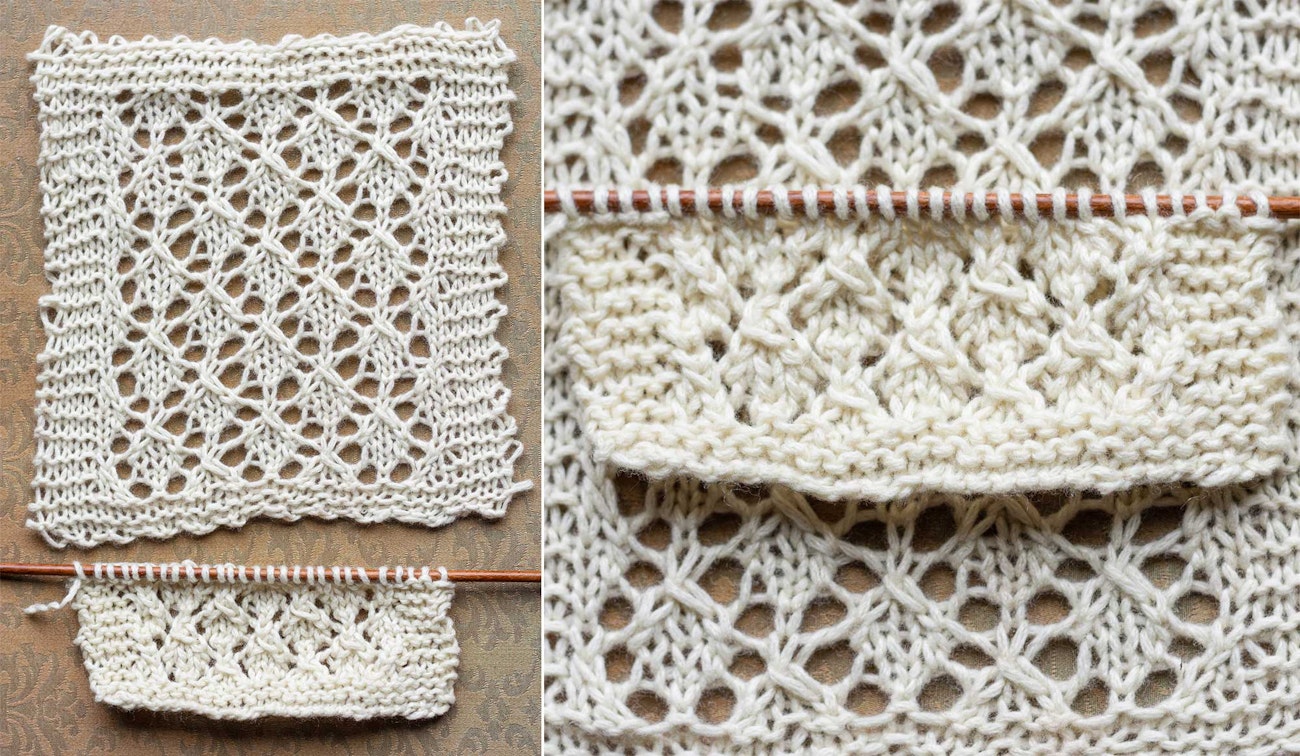 Photos of Pamela’s lace squares show how much larger the blocked versions are compared to the swatches still on the needles. Photos by Pamela K. Schultz
Photos of Pamela’s lace squares show how much larger the blocked versions are compared to the swatches still on the needles. Photos by Pamela K. Schultz
How to Block Lace Knitting
To block lace, you’ll wet the fabric so it’s saturated but not dripping, then stretch it out, using something to hold the fabric in that stretched position while it dries. Once you remove it from the stretcher, you’ll notice that the lace motifs have opened up, becoming dazzling and giving the lace a silky drape.
First, submerge your shawl in a basin filled with lukewarm water and a little bit of wool wash. Let it sit for about twenty minutes, then rinse if your wool wash requires it. Do not agitate or knead your knitting at this stage. Instead, gently swish the shawl around in the water, then lift it out, supporting it as a bundle in your hands and gently squeezing out excess water.
Lay the shawl flat on a clean towel or two, depending on its size. Roll the shawl up in the towel and gently squeeze again so that the shawl is still damp but not dripping wet.
Now the fun begins! Your shawl is ready to transform from a wet lump that resembles cheesecloth into a stunning masterpiece.
There are many different surfaces you can use to block a lace shawl. Many people like to use a flat, padded surface, such as foam blocking mats. In a pinch, I’ve covered a bed with a spare sheet and extra towels to use as my blocking surface. There’s not as much airflow with this option, and no one likes damp sheets, so a small fan blowing on the lace as it dries helps speed up the process.
Keeping it Even
It helps to establish points of reference. For a triangular shawl, this is often the center rib. For a rectangular shawl like the Whisper Wrap, this is the garter stitch selvedge that runs lengthwise. Keeping these points of reference straight and even is key to a beautifully blocked shawl.
When I first learned to block lace, I was armed with a box of rustproof T-pins. I’d laboriously pin out every point of a shawl, stretching and measuring to make sure everything was symmetrical. I’d carefully ration pins for the most important parts, getting nervous when I started to run low. Then I learned about blocking wires.
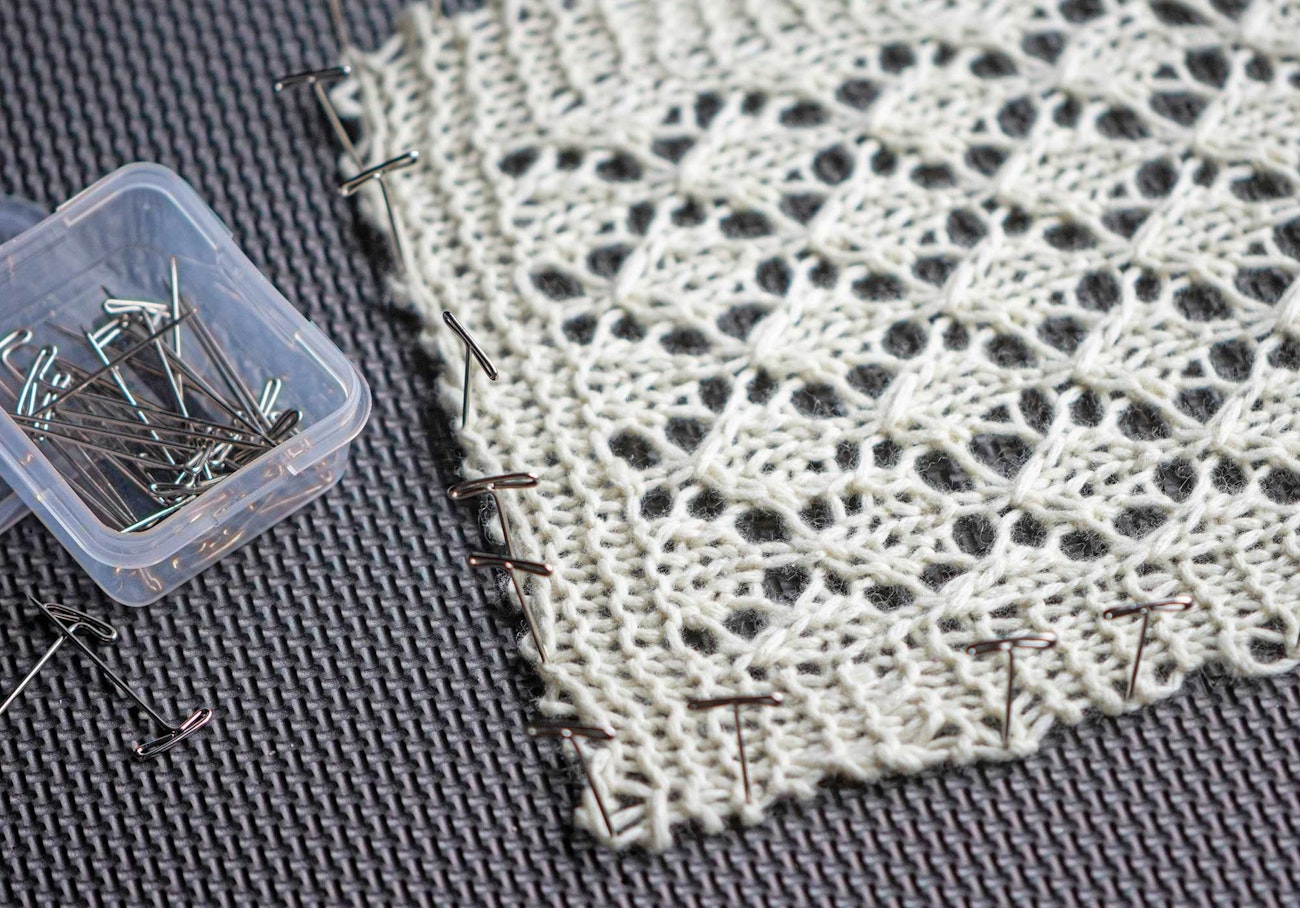 Adding T-pins to each point on the shawl can become labor intensive; is there a better way? Photo by Pamela K. Schultz
Adding T-pins to each point on the shawl can become labor intensive; is there a better way? Photo by Pamela K. Schultz
To use blocking wires, you’ll thread the wires through each of the points you would have otherwise pinned. Then you’ll pull the wires apart and pin them in place. This is much easier and faster than pinning every point!
Blocking wires are so easy to use, you may be tempted to pull so hard that you break a stitch. You want to pull tight, but when the lace just starts to pull back against the wires or pins, that’s probably enough. Remember that as the lace dries, it will continue to shrink and get even tighter.
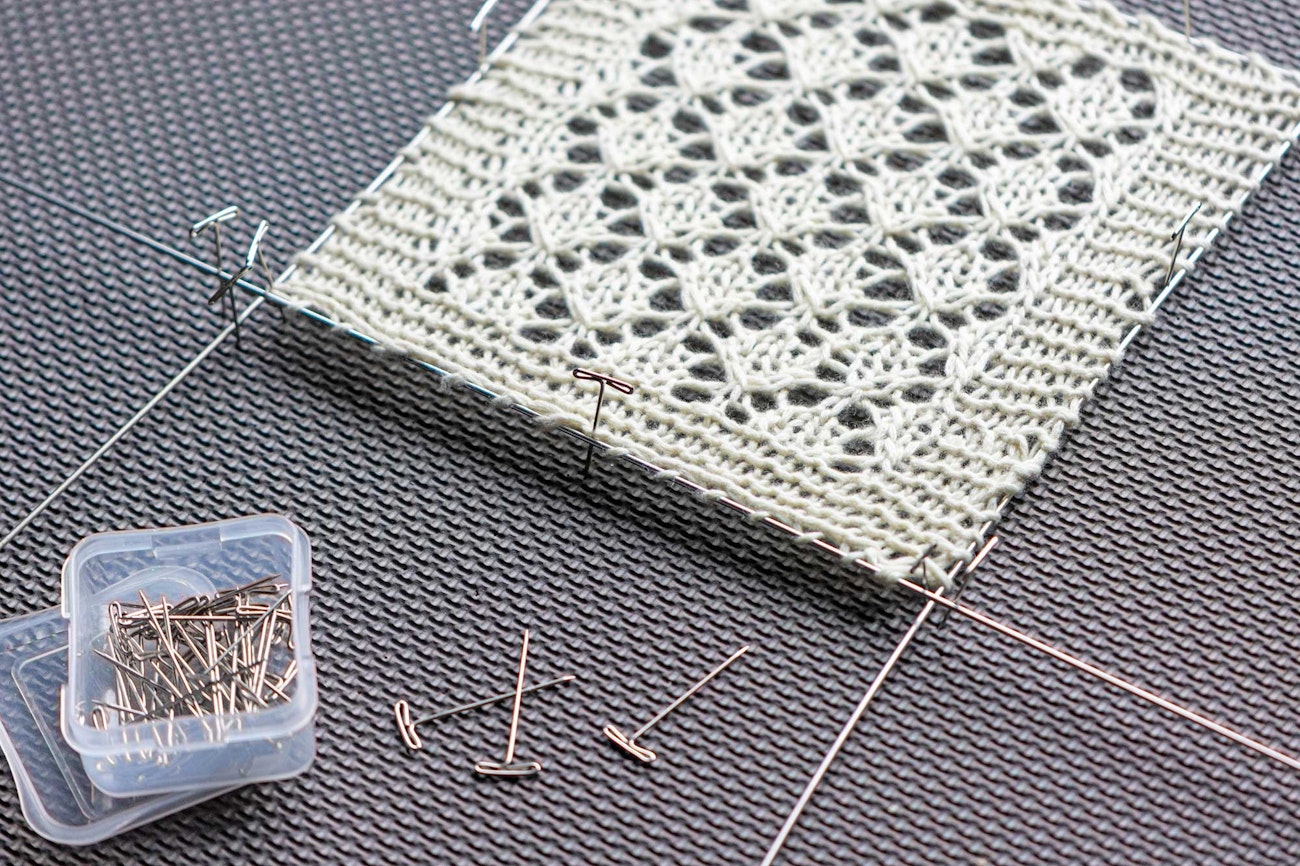 Blocking wires to the rescue! Photo by Pamela K. Schultz
Blocking wires to the rescue! Photo by Pamela K. Schultz
Take it Vertical
Shetland lace is often blocked (or “dressed”) on a wooden frame consisting of four long bars of wood secured at the corners. Pegs run along each side. Before wetting the lace, a temporary, smooth, undyed thread is sewn through each outer point of a shawl. Once wet, the thread is looped over the pegs and gradually tightened until the shawl is evenly stretched.
This frame, sometimes called a hap stretcher or shawl, is usually leaned against a wall so it doesn’t take up too much floor space. It can also be taken outside on a sunny day to speed up drying time.
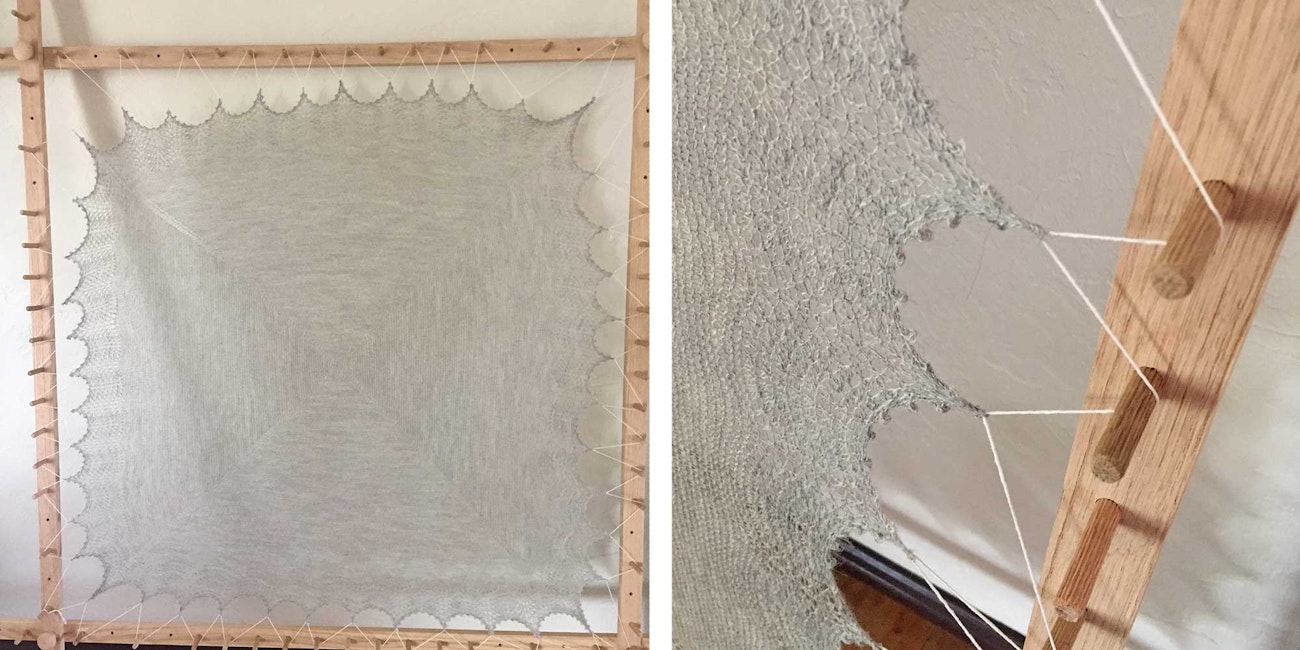 Pamela demonstrates how to block her Shetland shawl on a hap stretcher. Photo by Pamela K. Schultz
Pamela demonstrates how to block her Shetland shawl on a hap stretcher. Photo by Pamela K. Schultz
Final Tips
Regardless of which tools or method you choose, it’s best to block your lace so it’s tight, but so you’re not fighting the lace to stretch more than it wants to. Once you’ve removed the lace from the blocking apparatus, it will relax a little bit but still retain all the smooth stitches and overall shape created by blocking.
While blocking lace does take a little bit of extra time, the payoff is well worth it. When people discover you knit it yourself, they’ll be amazed, and you’ll know the secret is in the blocking! Try it yourself with the Whisper Wrap.

